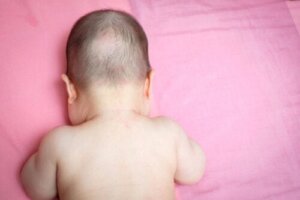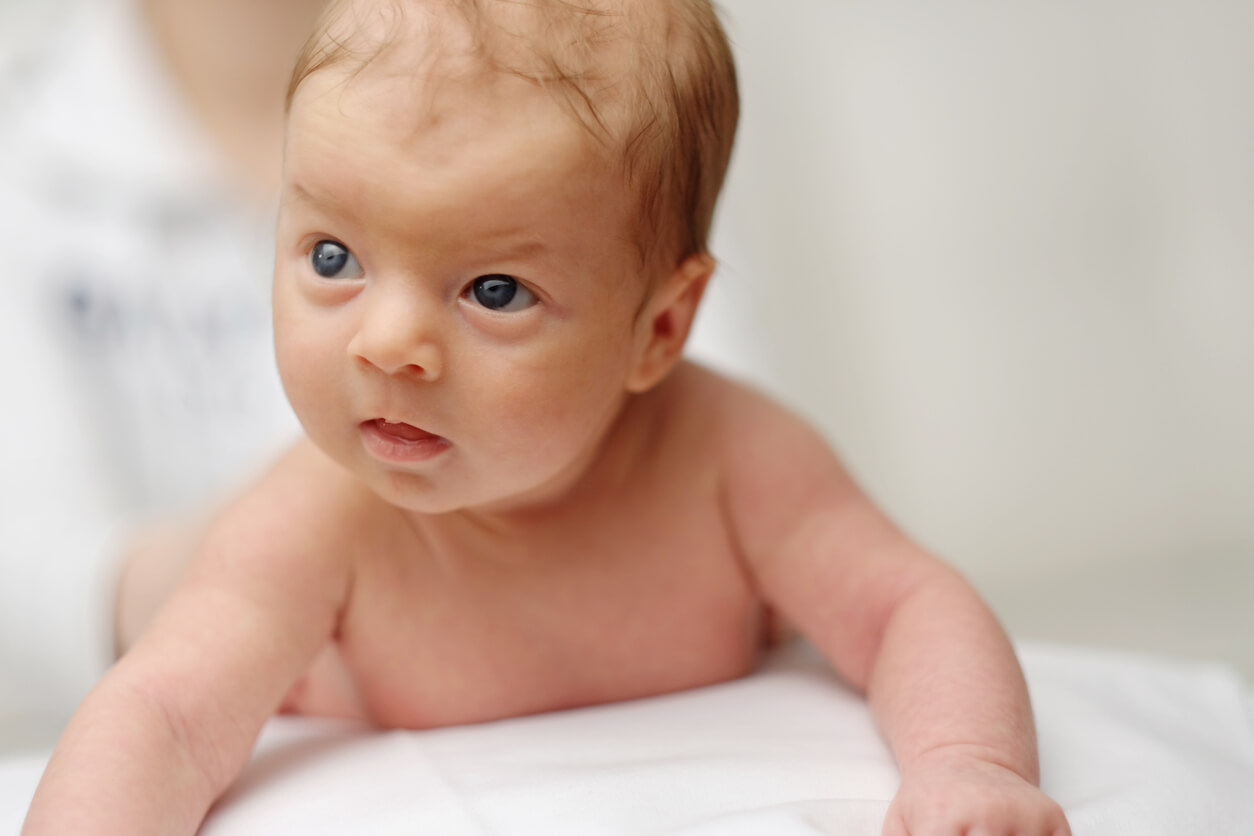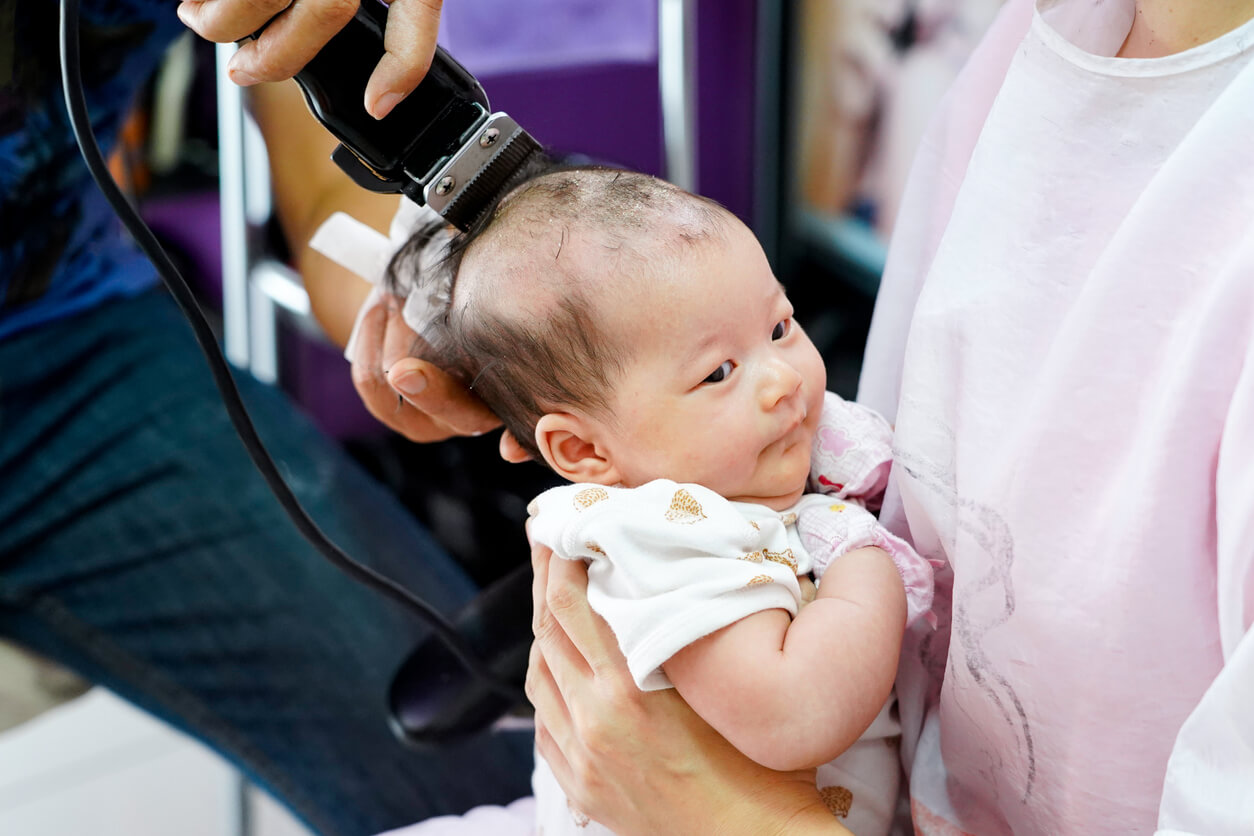Why Does My Baby Have Bald Spots?


Written and verified by the dermatologist Maria del Carmen Hernandez
Many parents are alarmed when they notice that their newborn baby has bald spots. While little ones may have a full head of hair at first, they may lose much of it from one day to the next. However, this hair loss is a normal process for young children during the first six months of life. Keep reading to find out all the details.
Why do babies lose hair?
Each hair fiber has its own stage of growth and rest that lasts three years and three months respectively. In general, about 15% of hair remains in the resting stage. In addition, hair can regenerate without alopecia becoming evident. Therefore, as it falls out, new hair begins to grow in such a way that the transition is hardly noticeable. However, there are occasions in which alopecia is local and circumscribed, as the amount that falls out is greater than the amount that grows.
There are newborns with greater hair density and others with less. Both conditions are normal. In addition, not only can the amount of hair a baby’s born with change, but also the color.
Transient hair loss in newborns
According to a publication in the European Journal of pediatrics, this transient hair loss is characterized by its origin in certain areas without hair in newborns up to 3 months old. Therefore, it’s not a disease but a normal consequence of the development of the hair cycle from the moment of gestation.
Hair has well-defined growth phases. In fact, already in the womb, most of a baby’s is in an analogous phase, i.e. growth.
You may be interested in: Trichotillomania in Children: What is it?

The stages of baby hair
Most newborns have fine, very soft hair that will begin to fall out unevenly after a few weeks. Therefore, the baby will develop bald patches in some areas of the head.
Hair loss is transitory, a product of the growth cycle of the hair fiber that began during gestation. And, after that, the resting period will begin, which lasts three months. It’s here, according to some publications by the American Academy of Pediatrics, where hair will be shed to make room for new hair, which is known as telogen effluvium.
As there’s a small amount of hair, bald patches in newborns are very noticeable until the hair grows again. The process of growth stages occurs in a progressive manner. It first grows in the frontal area and then spreads to the sides and back.
Factors influencing babies and bald spots
The sleeping position of the newborn may be associated with localized hair loss. In these cases, hair’s lost in a specific area, which is the area that rests on the bed the longest, especially in the occipital region. This situation is known as occipital neonatal alopecia. It can even be observed in the frontal part of the head.
Experts believe that the hormones transferred by the mother to her newborn also play a role in the development of bald patches. For this reason, in the months following birth, there’s hair loss in the newborn, as well as in the mother. As time goes by, new hair will appear and may differ in color and texture.
So, should babies have their hair cut?
Newborns’ hair is very thin and is usually very light, which sometimes makes it imperceptible, like fluff. In fact, the small amount of hair may remain until the first year of life.
Some parents decide to cut their baby’s hair completely to disguise bald patches. However, this doesn’t mean that the hair will grow faster and stronger. The hair will start to grow on its own and will do so in a healthy way with the right care. Cutting baby hair can allow it to grow back more evenly and evenly.
How to cut a baby’s hair: How to Cut Your Baby’s Hair?

Should you see your pediatrician?
In some cases, hair loss may be due to health issues. For example, seborrheic dermatitis is a dermatological condition that causes thick scales and can also cause hair loss. Even if reddish scaling is evident in the region of the bald spot, it could be due to a fungal infection called dermatophytosis. In these situations, it’s best to consult a medical specialist to determine if the baby’s bald spots are natural or due to a particular cause.
Hair loss in newborns
In conclusion, hair loss in newborns is a completely natural process. However, if the baby remains with bald spots after the first year of life or if there are any manifestations, such as flakes on the scalp, it’s best to consult a medical specialist.
Many parents are alarmed when they notice that their newborn baby has bald spots. While little ones may have a full head of hair at first, they may lose much of it from one day to the next. However, this hair loss is a normal process for young children during the first six months of life. Keep reading to find out all the details.
Why do babies lose hair?
Each hair fiber has its own stage of growth and rest that lasts three years and three months respectively. In general, about 15% of hair remains in the resting stage. In addition, hair can regenerate without alopecia becoming evident. Therefore, as it falls out, new hair begins to grow in such a way that the transition is hardly noticeable. However, there are occasions in which alopecia is local and circumscribed, as the amount that falls out is greater than the amount that grows.
There are newborns with greater hair density and others with less. Both conditions are normal. In addition, not only can the amount of hair a baby’s born with change, but also the color.
Transient hair loss in newborns
According to a publication in the European Journal of pediatrics, this transient hair loss is characterized by its origin in certain areas without hair in newborns up to 3 months old. Therefore, it’s not a disease but a normal consequence of the development of the hair cycle from the moment of gestation.
Hair has well-defined growth phases. In fact, already in the womb, most of a baby’s is in an analogous phase, i.e. growth.
You may be interested in: Trichotillomania in Children: What is it?

The stages of baby hair
Most newborns have fine, very soft hair that will begin to fall out unevenly after a few weeks. Therefore, the baby will develop bald patches in some areas of the head.
Hair loss is transitory, a product of the growth cycle of the hair fiber that began during gestation. And, after that, the resting period will begin, which lasts three months. It’s here, according to some publications by the American Academy of Pediatrics, where hair will be shed to make room for new hair, which is known as telogen effluvium.
As there’s a small amount of hair, bald patches in newborns are very noticeable until the hair grows again. The process of growth stages occurs in a progressive manner. It first grows in the frontal area and then spreads to the sides and back.
Factors influencing babies and bald spots
The sleeping position of the newborn may be associated with localized hair loss. In these cases, hair’s lost in a specific area, which is the area that rests on the bed the longest, especially in the occipital region. This situation is known as occipital neonatal alopecia. It can even be observed in the frontal part of the head.
Experts believe that the hormones transferred by the mother to her newborn also play a role in the development of bald patches. For this reason, in the months following birth, there’s hair loss in the newborn, as well as in the mother. As time goes by, new hair will appear and may differ in color and texture.
So, should babies have their hair cut?
Newborns’ hair is very thin and is usually very light, which sometimes makes it imperceptible, like fluff. In fact, the small amount of hair may remain until the first year of life.
Some parents decide to cut their baby’s hair completely to disguise bald patches. However, this doesn’t mean that the hair will grow faster and stronger. The hair will start to grow on its own and will do so in a healthy way with the right care. Cutting baby hair can allow it to grow back more evenly and evenly.
How to cut a baby’s hair: How to Cut Your Baby’s Hair?

Should you see your pediatrician?
In some cases, hair loss may be due to health issues. For example, seborrheic dermatitis is a dermatological condition that causes thick scales and can also cause hair loss. Even if reddish scaling is evident in the region of the bald spot, it could be due to a fungal infection called dermatophytosis. In these situations, it’s best to consult a medical specialist to determine if the baby’s bald spots are natural or due to a particular cause.
Hair loss in newborns
In conclusion, hair loss in newborns is a completely natural process. However, if the baby remains with bald spots after the first year of life or if there are any manifestations, such as flakes on the scalp, it’s best to consult a medical specialist.
All cited sources were thoroughly reviewed by our team to ensure their quality, reliability, currency, and validity. The bibliography of this article was considered reliable and of academic or scientific accuracy.
- Cutrone M, Grimalt R. Transient neonatal hair loss: a common transient neonatal dermatosis. Eur J Pediatr. 2005 Oct;164(10):630-2. doi: 10.1007/s00431-005-1707-y. Epub 2005 Jul 12. PMID: 16010567.
- Hair loss (Alopecia). [Internet] Disponible en: https://www.healthychildren.org/English/health-issues/conditions/skin/Pages/Hair-Loss-Alopecia.aspx
- Pediatric Tinea Infections (Ringworm). [Internet] Disponible en: https://childrensnational.org/visit/conditions-and-treatments/skin-disorders/tinea-infections-ringworm
-
Grubbs H, Nassereddin A, Morrison M. Embryology, Hair. [Updated 2022 May 8]. In: StatPearls [Internet]. Treasure Island (FL): StatPearls Publishing; 2022 Jan-. Available from: https://www.ncbi.nlm.nih.gov/books/NBK534794/
This text is provided for informational purposes only and does not replace consultation with a professional. If in doubt, consult your specialist.








